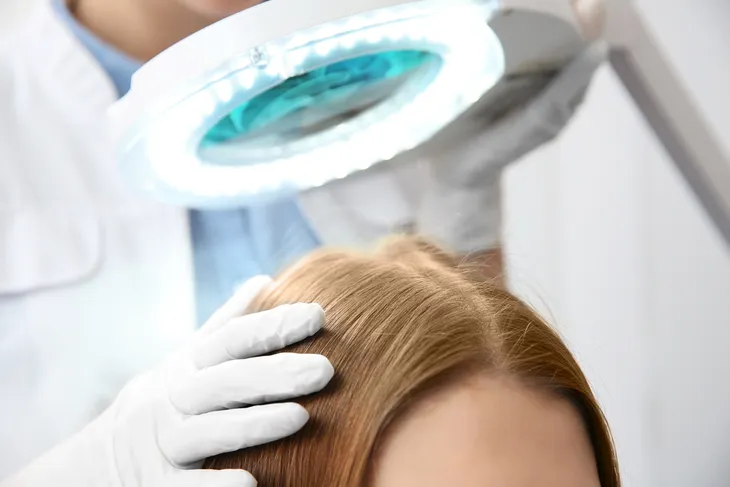When you think of all the places where you can get skin cancer, you probably think of your face, arms, and legs. But, it turns out skin cancer can grow in just about any area of your skin. According to the Centers for Disease Control and Prevention (CDC), skin cancer is the most common type of cancer in the United States. Basal cell and squamous cell carcinomas are the two most common and easily treatable types of skin cancer. Melanoma is less common and causes the most deaths reports the CDC.
The number one way to protect yourself from skin cancer is to stay out of ultraviolet (UV) radiation from sunlight. This includes both during the summer and winter, and even on cloudy days. Not every type of skin cancer is completely preventable and it’s important to know all the places it can pop up on your skin.
Keep reading to learn more about the unusual places you can get skin cancer.
Scalp
One place on your body you might not suspect skin cancer is on your scalp. For most people, it’s well protected from the sun because of their hair but that doesn’t necessarily eliminate your risk for skin cancer. According to WebMD, “13-percent of total skin cancers are on the scalp, usually the less serious nonmelanoma cancers like basal cell and squamous cell carcinomas.” Skin cancer on your scalp can look like a small, smooth lump that bleeds or is crusty.
To protect your scalp from skin cancer, wear a hat when you’re outside in the sun. If a hat isn’t feasible, then use sunscreen. Spray sunscreen is a good way to get protect your scalp from UV sunlight without using greasy lotion sunscreens. If you think a spot on your scalp is skin cancer, see your doctor for evaluation/confirmation.
Under Your Fingernail
Who would’ve ever thought you can get skin cancer under your fingernail or toenail? It’s true, subungual melanoma is a type of skin cancer that grows in the nail bed tissue underneath the nails. It looks like a dark vertical line that can spread slowly, says Arizona Dermatology. It’s not usually caused by sunlight exposure and is sometimes confused for a fungal infection or bruise. But unlike a bruise or infection, the dark area doesn’t grow out.
Before you go to your dermatologist for a skin cancer check, make sure to remove any nail polish or acrylic nails to let your doctor get a good look at your nail beds. Thankfully, this type of cancer is rare. The source reports that, “subungual melanomas account for about 2-percent of all melanomas, and they can be found on either your finger or toes.”
Soles of Your Feet
Cancer on the bottoms (soles) of your feet, it’s true it can happen! This type of skin cancer is called acral lentiginous melanoma, says WebMD. “It typically starts as a flat dark patch that is clearly distinct from the skin around it, but it may sometimes be reddish or orange in color,” reports the source. This melanoma can look like many different foot conditions, such as moles, ulcers, splinters, or bruises.
It’s time to start giving the soles of your feet the same attention that you give the rest of your body when it comes to skin cancer. As acral lentiginous melanoma (ALM) grows, it will become more irregular in size. It will grow deep into the skin and surrounding tissue, making it painful to walk. Some people may mistake it for a plantar wart. Always be sure to call your doctor if you have any new skin growths.
Ears
It might not be too surprising that you can get skin cancer on your ears. They stick out from your head and aren’t covered from the sun when you wear a typical baseball hat. The unusual thing about skin cancer on the outside of the ears is that it can spread to the inside of the ears. According to WebMD, squamous or basal cell skin cancer can spread to the inside of your ear if it isn’t treated quick enough.
The inside of your ear has a canal that connects your outer ear to the middle ear. It’s in your middle ear that sound is transmitted to your brain. Your ear is an easy place to overlook when putting on sunscreen. But, you should always be diligent and cover your ears. When you don’t have sunscreen or are unable to put it on your ears, you should wear a wide brim hat. Your ears and skin will thank you!
Palms of the Hands
Another unusual place you can get skin cancer is on the palms of your hands. “If you have darker skin, melanoma is more likely in body areas that don’t get much sun, such as the palms of the hands…” says WebMD. And just like the soles of your feet, ALM is usually the type of cancer that affects the palms of the hands. This can be a serious diagnosis, usually because those diagnosed don’t realize it until they have had it for a while.
Most melanomas are caused by UV light exposure, but ALM doesn’t seem to be caused by sunlight. “ALM sometimes develops from an existing mole, but it can also occur for no apparent reason on healthy skin,” reports Medical News Today. Look for a raised or thick patch of skin on your palm and if you see anything suspicious put in a call to your dermatologist.
Mucous Membranes
Another unusual spot to get skin cancer is on your mucous membranes. Mucous membranes line the mouth, throat, urinary tract, and anus. Skin cancer in one of these locations is incredibly rare but does occur. Mucosal melanoma makes up only 0.03-percent of all new cancer diagnoses, says the Cancer Network.
Compared to other types of melanoma, mucosal melanoma usually occurs later in life, with diagnosis typically around 70 years of age says the Cancer Network. The incidence of mucosal melanoma has not gone up over the years as other melanomas have, but the 5-year survival rate is much lower. It’s also much more common in women than in men, 87-percent higher in women than in men to be exact!
Eyelids
While an unusual place to think of for skin cancer, the eyelids are actually a somewhat common place for cancer to form. According to Arizona Dermatology, “the eyelids are a common site for non-melanoma skin cancers (between 5- and 10-percent of basal cell and squamous cell carcinomas occur on the eyelid).” When comparing the upper and lower eyelids, the lower eyelid is where the cancer develops most of the time.
Skin cancer on the eyelid is usually caused by the sun. To help protect yourself, wear a hat and sunglasses when you’re outside. If you do develop skin cancer in an eyelid, it can be surgically removed and is not serious if done early says WebMD. There are so many different places for skin cancer to grow, who would’ve thought the eyelid is one of the more common spots!
Eyes
Melanoma is one of the most serious types of skin cancer. But, it turns out it can affect more than just your skin, it can cause cancer in your eye. According to WebMD, “Skin cells called melanocytes grow out of control and form a tumor. It’s the most common form of cancer that starts in the eye, and it can spread to other parts of your body through your lymph nodes.” The cancer can cause changes in your vision or the actual appearance of your eye.
When melanoma starts in the eye, it usually starts in the uvea, or the middle layer of the eyeball, says the American Cancer Society. Rarely does it start in the conjunctiva (white part of the eye), but when it does, it is an aggressive form of cancer that grows into other nearby tissues. If you have vision changes or other concerns about your eyes, make sure you put in a call to your doctor to have it evaluated.
Lips
It seems like no spot on your body is immune to forming cancer, even your lips are at risk. Skin cancer that forms on the lips is typically non-melanoma cancer, usually basal cell or squamous cell carcinoma, says WebMD. Interestingly enough “your lower lip is 12 times more likely to get it than your upper lip, which doesn’t get as much sun” reports the source. And men should be aware that they are more likely to develop lip cancer than women.
Two risk factors for developing skin cancer on your lips are exposure to sunlight and human papillomavirus (HPV) says WebMD. Thankfully, it’s easy to find lip moisturizers with SPF in them. This will help protect your lips from the sun’s damaging UV rays, which will ultimately decrease the likelihood of developing skin cancer. Talk to your doctor about ways to minimize your risk for contracting HPV, which is considered a sexually transmitted infection (STI).
Tongue
Our last unusual place that you can get skin cancer is on the tongue. It’s usually a squamous cell cancer, which is more common if you use tobacco or drink alcohol, reports WebMD. It can look like a sore on your tongue that just doesn’t go away. Depending on the exact location of the cancer, it can be diagnosed as tongue cancer or oropharyngeal cancer.
Some of the symptoms that you might notice are flat, white patches that don’t scrape off the tongue easily, sores on the tongue, a painful tongue, or a hoarse voice says Medical News Today. These symptoms can mimic other conditions making it hard to determine the exact cause. Your doctor will take a biopsy of skin cells to help decide what’s causing the issues and if it is in fact cancer.
Prevention
Skin cancer can affect anyone. It’s important to know your family history and keep your doctor in the loop with any medical changes. The best way to manage skin cancer is to never get it. While many of the risk factors for skin cancer are things you can control, such as staying out of the sun and avoiding infections. There are many risk factors that you have no control over, such as your genetics (family history) and ethnicity (skin color).
When skin cancer is diagnosed early, it is often very treatable. This really illustrates the importance of checking your skin on a regular basis. If you have any questions about moles or other skin changes, make an appointment with your primary care physician or a trusted dermatologist. They will be able to guide you through a thorough skin check and determine if any skin changes are serious.














